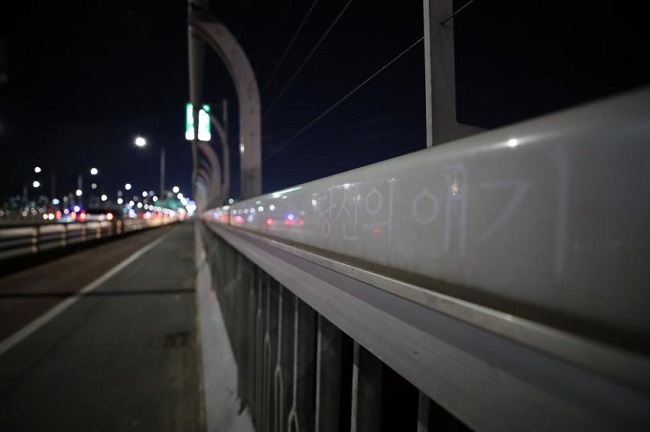SEOUL, June 5 (Korea Bizwire) — During the peak of the pandemic between 2020 and 2022, South Korea grappled with a troubling reality: the number of suicides, totaling 39,267, exceeded the count of coronavirus-related deaths, which stood at 32,056.
This disconcerting trend has sparked serious concerns within the country.
According to a recent report from the British magazine The Economist, South Korea currently holds the unenviable position of having the highest suicide rate among all Organization for Economic Cooperation and Development (OECD) nations.
Of particular distress is the alarming increase in suicides among women.
Comparing South Korea to other OECD countries, the nation’s suicide rate stands at 24.1 per 100,000 people, surpassing rates observed in Lithuania (20.3) and Slovenia (15.7).
The situation is even more dire for women, with a suicide rate of 13.4, ranking them fourth globally. Only Lesotho, Guyana, and Zimbabwe report higher rates of female suicide.
This concerning reality, coupled with a fertility rate of 0.78 children per woman, the lowest in the OECD, has created an undeniable and profound national crisis.
Addressing these alarming suicide rates has become a pressing challenge for South Korea, particularly as they coincide with the rise of information sharing and the proliferation of online platforms related to suicide, thus it is increasingly important to take proactive measures in preventing online assisted suicide.
In a bid to combat the rising tide of online content that aids or encourages suicide, the Ministry of Health and Welfare, in collaboration with the National Police Agency (NPA) and the Korea Foundation for Suicide Prevention (KFSP), has announced the launch of a comprehensive campaign.
From May 5 to 16, this joint initiative aims to eradicate suicide-inducing information from public platforms, as reported by the ministry on Sunday.
Recent reports indicate a worrisome surge in the dissemination of content facilitating suicide, especially affecting vulnerable youth.
Urgent action has become imperative, as the spread of this distressing information poses a significant threat to the well-being of individuals susceptible to its influence.
The scope of suicide-inducing information encompasses a wide range of perilous content, including the recruitment of suicide companions, explicit suggestions of suicide methodologies, and the trading or employment of hazardous items associated with self-harm.
Disturbing data compiled by the Korea Life Respect and Hope Foundation reveals a consistent upward trajectory of suicide-inducing information reports over the past five years, spanning from 2018 to last year.
The figures indicate a disturbing escalation from 32,392 to 32,588, further climbing to 90,772, 142,725, and eventually peaking at 234,664.
The statistics highlight a staggering surge in reports of posts soliciting suicide companions, which skyrocketed to 18,889 last year, nearly five times the preceding year’s figure of 3,920.
Additionally, reports of specific suicide methodologies tripled to 6,700 last year, compared to 2,215 in the previous year.
Moreover, the number of suicide-related photographs or videos reached 126,742, reflecting a notable 76.1 percent surge from the previous year’s 71,971.
The urgency of addressing this distressing issue was underscored by a tragic incident that took place on April 16 when the suicide of a teenage student in Gangnam district in Seoul, was livestreamed on social media.
This incident raised concerns about the potential for copycat behavior among vulnerable youth.
To combat this crisis, individuals aged 19 and above who are interested in suicide prevention are invited to participate in education programs and engage in reporting activities through the Media Suicide Information Monitoring System.
By identifying and reporting suicidal content directly to information and communication service providers, participants can contribute to its removal, with emergency assistance available through the cooperative efforts of the NPA.
A crucial observation has emerged, emphasizing the paramount significance of attention and support from loved ones for individuals struggling with suicidal thoughts.
The recently published 2021 Psychological Autopsy Interview Results Report by the health ministry sheds light on a concerning statistic: a staggering 94 percent of suicide victims exhibited warning signs, while only a mere 22.7 percent of bystanders were able to recognize these indicators.
This revelation underscores the urgent need for increased awareness and understanding surrounding the warning signs of suicide.
Loved ones, friends, and acquaintances play a pivotal role in identifying and responding to these distress signals.
By fostering an environment of empathy, compassion, and active engagement, it becomes possible to intervene and provide the necessary support to those in need.
“We aspire to foster a culture that esteems the sanctity of life by empowering individuals to proactively identify and block suicide-inducing information,” expressed Kwak Sook-young, a mental health policy officer at the health ministry.
Dr. Hwang Tae-yeon, Chairman of the KFSP, emphasized the imperative for not only the public but also information and communication providers to actively participate, thereby eliminating online suicide-inducing content from digital spaces.
Ashley Song (ashley@koreabizwire.com)









